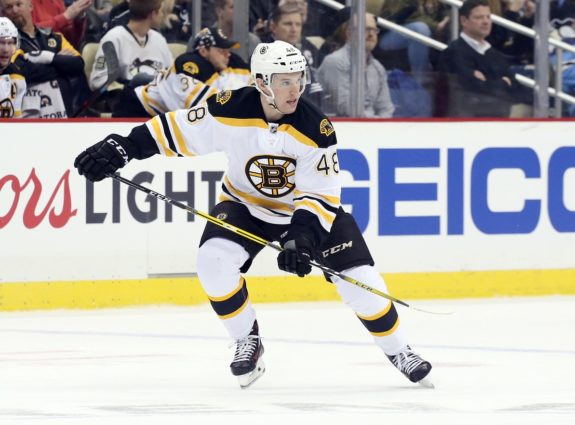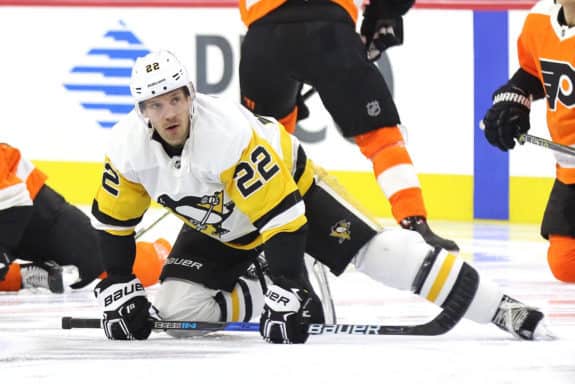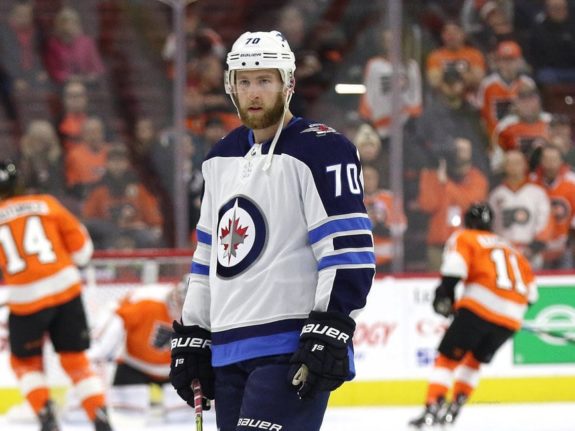This offseason, the Boston Bruins signed Matt Grzelcyk to a two-year deal worth $1.4 million annually. The contract seems to state “prove yourself and a payday will follow.” The defenseman’s performance to this point has already proved one thing, however – the Bruins’ bad luck with young, puck-moving defensemen may soon reach its end.
During his rookie season, Grzelcyk put up three goals and 12 assists in 61 appearances, soaking up most of the action on the third defensive pairing. The Massachusetts native received chunks of power play time, however, averaging 16:44 of ice time per game. While plus-minus stats aren’t always indicative of a player’s overall impact on a game, a plus-21 rating supports the theory that Grzelcyk hasn’t exactly been hazardous to his team.

While his defensive play could use some work, the 5-foot-9, 174-pound puck-mover has plenty of time to improve his game behind his own blue line. The fact of the matter is that he is just 24-years-old and it often takes defensemen a slightly longer time to reach their ceilings than forwards. Grzelcyk’s progression will continue next season, and many expect him to play an important role in Boston’s defensive core – even if he is to stick on the third pair.
Matt Hunwick
Averaging 16:59 in ice time over the course of 53 games during the 2008-09 season, Matt Hunwick potted six goals and 21 assists. Eight of those helpers were produced as a result of a Bruins power play. He was quite solid as a power-play quarterback during his rookie year but fell into a decline during his sophomore season. The following year, at the age of 24, Hunwick tallied just six goals and eight assists for Boston in 76 games.
While the Michigan native is indeed a defenseman, his defensive skills were clearly – and in many ways still are – lacking. Weighing in at 200 pounds with a 5-foot-11 frame, Hunwick has often been pushed around in his own zone. He struggles in net-front battles and seems to be outmuscled along the boards far too often. The defenseman has primarily functioned as a puck-moving machine, and when he failed to live up to that title in his first 22 games of the 2010-11 season, Hunwick was traded to the Colorado Avalanche.

Since the Bruins-Avalanche trade, Hunwick has been passed around quite a bit, finding temporary homes with the New York Rangers, Toronto Maple Leafs, and Pittsburgh Penguins. Next season, Hunwick will play for the Buffalo Sabres – his sixth NHL team in 12 seasons. To date, the alleged puck-mover has been credited with 166 takeaways and 243 giveaways – not what you want to see from a defenseman who is expected to lead your team’s breakout. Hunwick turned out to be a flop after a solid rookie campaign – something Grzelcyk must avoid.
Steven Kampfer
Steven Kampfer has never played more than 47 games in a season. In his rookie year during the 2010-11 campaign, the defenseman registered five goals and five assists in 38 games for Boston. His defensive game never reached expectations and the Bruins had him swap his black and gold uniform for one that sported the Minnesota Wild’s logo instead. He played just 13 games with the Wild before being sent to the Flordia Panthers. After less than two seasons with the Panthers, Kampfer joined the New York Rangers.
Due to the 5-foot-11, 195-pound player’s subpar defense, he was forced to rely on offensive production to keep his head above water at the NHL level. But that offensive game never came to fruition, dubbing him a utility player for most of his hockey career. If your sixth defenseman goes down with an injury, Kampfer is a decent replacement but nothing more. He has never seemed to be able to lock down a full-time gig in the NHL.
The Bruins escaped Kampfer’s dwindling potential early and are a better team for it. However, due to what has been widely deemed a flop, Boston was set back a handful of years and was required to either develop or acquire another speedy, third-pair defenseman. While not treacherous, it certainly didn’t help the Bruins’ effort to claim another Stanley Cup after 2011’s championship season.
Joe Morrow
Appearing in three different NHL uniforms in his 121-game career, Joe Morrow has yet to make a sizeable impact in hockey’s most competitive league. The Bruins received Morrow from the Dallas Stars in the seven-player Tyler Seguin trade back in 2013. While the Edmonton native was originally expected to bolster Boston’s bottom pair someday, that failed to become a reality.
In 65 games with the Bruins, Morrow netted just two goals and seven assists. Due to his lack of offensive production and becoming a liability in his own zone, the defenseman never reached his potential and was shipped off to the Montreal Canadiens in time for the 2017-18 season before moving on to the Winnipeg Jets.

The 6-foot, 196-pound defenseman tallied 16 points in 58 games last year but has consistently struggled when it comes to his most important function: defense. As a member of the Jets, Morrow must prove himself to be a day-to-day starter. Otherwise, he will be designated to the rafters where he will sit idly by until an injury delivers him another opportunity to make a mark.
If Grzelcyk takes a hard look at his predecessors, he will see two consistencies. The first, ironically, includes an inconsistency: offensive play. The puck-movers’ greatest value is just that – puck-moving – and if he fails to fill that role night after night, the Bruins might as well turn to Adam McQuaid who has more experience defensively and is a proven penalty killer.
That leads to the second consistency which takes place in Boston’s own zone. Despite his small frame, the current Bruin can’t allow himself to be knocked off the puck and outplayed in front of his own net. He has not been a liability in his own zone thus far, but his defensive game could definitely use some fine-tuning heading into the 2018-19 season.
Grzelcyk has shown that he is very capable of reversing what has become somewhat of a curse for Boston. Small, agile defensemen have not panned out for the Bruins in recent years. If Grzelcyk can learn from Hunwick, Kampfer, and Morrow’s woes, he stands a chance of staying in a black and gold jersey for years to come.